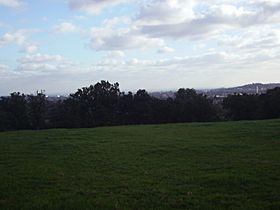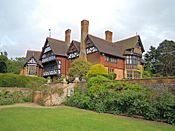Grim's Ditch (Harrow) facts for kids
Quick facts for kids Grim's Ditch |
|
|---|---|

View towards Harrow from near summit of Grim's Ditch
|
|
| Highest point | |
| Elevation | 144 m (472 ft) |
| Geography | |
|
Lua error in Module:Location_map at line 420: attempt to index field 'wikibase' (a nil value).
|
|
| Parent range | The Grim's Ditches |
| OS grid | TQ138928 |
| Topo map | OS Explorer 173 |
| Climbing | |
| Access | |
Grim's Ditch is a very old and long earthwork, which is like a big ditch and bank built into the ground. It's also known as Grim's Dyke or Grimes Dike. You can find it in the London Borough of Harrow, which used to be part of Middlesex. This earthwork gives its name to the gentle hill it sits on, which also marks the border of Hertfordshire.
The Grim's Ditch originally stretched for about 6 miles (10 km). It went from the edge of Stanmore (near a high part of London called Stanmore Hill) all the way to the north of Pinner Green – Cuckoo Hill. Today, you can still see parts of it starting from Harrow Weald Common. It's named after similar earthworks from the Roman Britain time. There are seven of these "Grim's Ditches" in central and southern England.
Contents
Exploring Grim's Ditch
Walking Paths and Views
There's a high path called Old Redding that goes right through the middle of the Grim's Ditch ridge. From here, you can find a special viewpoint marked on maps. As you walk further along this "high road," you'll discover more amazing views through gaps in the trees.
London's High Points
Grim's Ditch forms part of the northern edge of London's landscape. The highest points in London are generally along its southern edge. However, one of the next highest points is Stanmore Hill, which is part of the Grim's Ditch. This is where London meets Bushey, Hertfordshire.
What You Can See
From Grim's Ditch, you can see many famous landmarks:
- You can spot parts of Central London, including The Shard. This tall building is higher than any hill in London or the surrounding counties!
- Looking south, past Harrow on the Hill, you might even see Leith Hill. With binoculars, you can spot its 20-meter-high tower.
- To the north and west, you'll see the beautiful Chiltern Hills. You might even make out Coombe Hill, Buckinghamshire.
The Stone Marker
The highest part of the trail is near what used to be the highest point of the old county of Middlesex. It's above the Grim's Dyke Golf Club, on a path called the 'Bushey Heath Walk'. This path leads to a small woodland with a tall BT microwave aerial. Near the fence, there's a stone marker placed by the Harrow Heritage Trust. It says:
"This ancient earthwork once stretched through Harrow for six miles from Cuckoo Hill, Pinner to Pear Wood, Stanmore, but now only parts remain. Named after Grim (another name for the English King (also the god of death), Woden)."
Grim's Dyke House: Hotel and Film Location
In the woods near the earthwork stands Grim's Dyke, a beautiful house. It was designed in 1870 by a famous architect named Norman Shaw for a Victorian painter, Frederick Goodall. Later, it became the country home of W. S. Gilbert. He was famous for writing the words for many popular operas, like those by Gilbert and Sullivan. Sadly, he had a heart attack and drowned while trying to save someone in the lake on the property.
Today, Grim's Dyke House is a hotel. It's often used as a setting for films and TV shows because of its historic look. Both the house and its gatehouse are special listed buildings, meaning they are protected because of their historical importance.
History of Grim's Ditch
Local stories and the name itself suggest that Grim's Ditch is at least 1,500 years old, possibly from the 5th or 6th century. An excavation in 1979 helped scientists figure out its age more precisely. They found that it might have been built around 50 AD (plus or minus 80 years). This means it could have been built by the Catuvellauni tribe as a defense against the Romans.
Fun Fact
The earthwork was so well-known that it even gave its name to the local telephone exchange for Stanmore. This is why the first three numbers of many phone lines in the area still start with the same digits!



